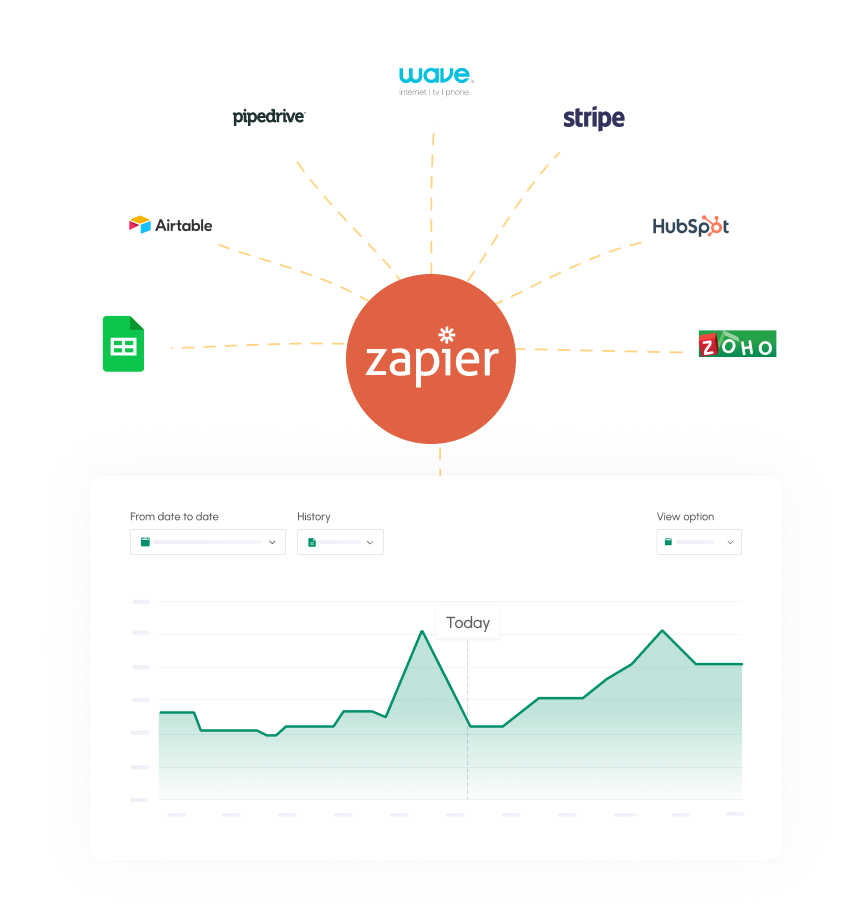
Every business – no matter its size or industry – can benefit from sales forecasting. In fact, forecasting is essential.
Why?
The most basic sales forecasting definition is this: the process of estimating future revenue based on how much of a product or service will sell in the forecasting period.
Having a glimpse into the future can help you make smarter decisions today.
Even if you understand the importance of sales forecasting, you may not know which forecasting model to use in your business. Let's explore some of the most common models used by companies today.
4 Common Sales Forecasting Models
While there are many sales forecasting methods, these four are the most common.
-
Time Series Models
Now that you know the importance of sales forecasting, let’s look at one of the most common sales forecasting methods: time series.
Time series forecasting projects future sales based on your past sales trends. This method also takes into account seasonality, which allows for more predictable future demand.
Simply put, the time series model uses data from previous periods (quarterly sales, monthly sales, etc.) and uses a mathematical equation to estimate future sales.
It’s important to understand the advantage and disadvantage of forecasting with this model.
Pros
Time series models have quite a few advantages.
They can help you:
- Identify patterns
- Predict lulls or spikes in sales
- Facilitate strategic planning
- Know when to execute your plans
Cons
While there are many advantages of time series forecasting, there are some limitations that need to be considered.
Time series forecasting isn’t always accurate and reliable.
Your forecasted revenue and actual revenue may not match 100% simply because some markets are highly volatile.
Time series forecasting can also be a time-intensive process and costly.
-
Regression Analysis
Objectives of sales forecasting can provide insights into your sales strategies. For example, you may forecast that sales will be up 25% in the next quarter. You have a lot of marketing campaigns running, so how do you know which ones are performing best?
Regression analysis.
This method of sales forecasting involves:
- Independent variables
- Dependent variables
Performance of a product’s sales would be the dependent variable that relies on marketing to sell goods. You'll find regression analysis requires you to collect a lot of data so that you can access:
- Internal factors that are impacting sales
- External factors that are influencing sales
If you’re a newer company without a lot of data at your fingertips, it may be best to focus on another form of sales forecasting.
Pros
There are a few advantages of sales forecasting using the regression analysis model.
Regression analysis:
- Can help you identify precise variables that impact your sales
- Is one of the most accurate forms of forecasting out there
Cons
Accuracy is one of the big advantages of using the regression model, but there is a drawback to this model: it’s complicated. Many companies shy away from using regression analysis because it’s not the easiest method to use.
-
Causal Analysis
A main advantage of forecasting is that you can use multiple methods of analysis to analyze your data. Causal analysis is a more comprehensive option that works to correct the limitations of sales forecasting.
Causal analysis requires you to:
- Extract your historical data (our next point covers this in greater detail)
- Analyze the relationship of why and where sales rise or fell
Causal analysis tries to understand the reason why trends exist. For example, if you notice sales fell in January, you can look at other data, such as economics or even a reduction in marketing expenditure, to learn the cause of the sales falling.
You can use causal analysis when sales rise and fall.
Pros
- Allows you to identify potential changes in your business landscape
- Creates a cause for sales fluctuations that you can then address as necessary
- Gives you the ability to use “educated assumptions” if the data for a cause doesn’t exist
Cons
- Causation can be inaccurate
- Requires historical data to run the analysis
Causal analysis takes a lot of time and resources to be done properly. You may also overlook external factors that contributed to a “cause,” making inaccurate changes to your business as a result.
-
Trend Analysis
Limitations of business forecasting are often due to a lack of data. If you use trend or historical analysis for your forecasts, you’ll learn about the future of your sales based on past data that you already have collected.
How does this work?
You’ll use common sales forecasting advantages, such as looking at categories of data, such as sales patterns by:
- Geographic location
- Seasonality
- Target audience
- Age group
- Etc.
You'll look through a certain period of time’s data that relates to some trend. For example, perhaps you know of a big shopping season coming up and you segment the data from December 1 – 31 to analyze.
Pros
- Trend data can help you better prepare for seasonal ups and downs
- Provides insights into potential product slumps or downward trends
- Forecasts upcoming trends that allow you to better understand upcoming changes
Cons
- Historical analysis can include data that is inaccurate in a current economic climate
For example, if you have historical data from 5 years ago and include it in your forecast, you’ll need to account for how the trends have changed year-over-year. Gaming consoles are a good way to visualize this.
During the first two or three years after launch, when supply is limited, consoles may sell at 100% of their normal rate. As consumers start to purchase the console, demand lowers, and last year’s sales may be 50% lower than the first year of sales.
If you don’t account for the drop in current demand for a product, you may create a forecast that is too optimistic and inaccurate.
Conclusion
The importance of sales forecasting – accurately – cannot be understated. Often, you’ll gain insights into potential sales patterns that you may otherwise miss. For example, you may use trend analysis to better understand seasonality in your operations.
Gaining insight into your sales will allow you to better prepare for slow or busy periods, better manage debt and make critical decisions about your company’s future.
Related posts:
You may be interested:
New:










